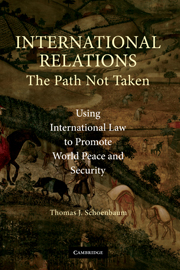Book contents
- Frontmatter
- Contents
- Preface and Overview
- 1 Introduction: Two Very Different Wars in Iraq
- 2 The Twenty-First Century – The End of History or a New Beginning?
- 3 International Power Politics
- 4 A New Global Order Based on International Law and Multilateralism
- 5 Peace and Security: Reinventing the United Nations
- 6 International Political Economy
- 7 International Environmental Protection
- 8 International Human Rights
- 9 International Crimes
- 10 Conclusions
- Index
- References
4 - A New Global Order Based on International Law and Multilateralism
Published online by Cambridge University Press: 23 July 2009
- Frontmatter
- Contents
- Preface and Overview
- 1 Introduction: Two Very Different Wars in Iraq
- 2 The Twenty-First Century – The End of History or a New Beginning?
- 3 International Power Politics
- 4 A New Global Order Based on International Law and Multilateralism
- 5 Peace and Security: Reinventing the United Nations
- 6 International Political Economy
- 7 International Environmental Protection
- 8 International Human Rights
- 9 International Crimes
- 10 Conclusions
- Index
- References
Summary
A NEW GLOBAL ORDER
The realist idea that each state has only isolated, individual interests has reduced validity today. In our world of the twenty-first century there is growing interest convergence – a growing harmony of interests – among states. States all over the world now have shared interests in peace, security, economic well-being, environmental quality, and even human rights. Therefore, international cooperation cannot be exceptional, as the realist model would have it; we need a system in which cooperation is the norm. In addition, states today are not the only international actors. International organizations, transnational companies, and international NGOs are as important or more important than many states.
The United States in particular should not take a narrow view of its national interest. As the preeminent global power the United States cannot appear to be acting as if its own self-interest is all that matters. The United States must act and be perceived as acting to benefit all humanity. U.S. policies uniquely affect all nations and peoples. If America exercises its power for narrow, partisan reasons, it inspires only resentment and condemnation. The global interests of the United States demand this broad view of its national interest. Taking a global approach instead of a narrow partisan view is not “international social work”; it is rational self-interest. The United States more than any nation is threatened by disorder anywhere in the world and benefits from a stable world order based on the rule of law.
- Type
- Chapter
- Information
- International RelationsThe Path Not Taken, pp. 54 - 95Publisher: Cambridge University PressPrint publication year: 2006



